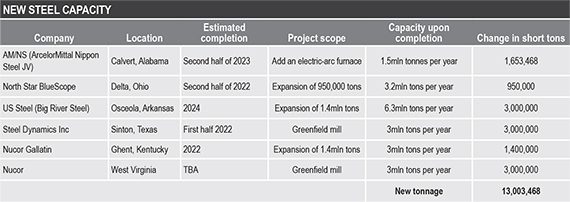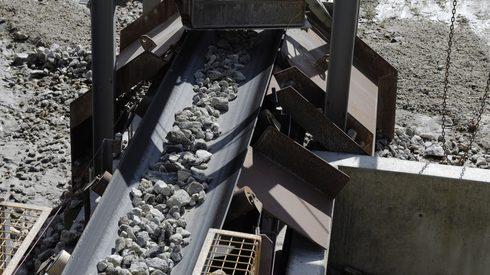More than 10 million tons of hot-rolled coil are scheduled to come online by the end of 2024, including 5.35 million tons by the end of 2022. Only the 3 million tons from Nucor Corp’s planned mill in West Virginia will be commissioned at an unknown later date.
The tonnage will come from a combination of greenfield capacity at two new locations, the expansion of capacity at three existing mills and the addition of an electric-arc furnace (EAF) at a location that did not previously have one.
Nucor West Virginia and Steel Dynamics Inc (SDI)’s Sinton, Texas, facility are greenfield mills. The expansions are at NorthStar BlueScope in Delta, Ohio; Nucor Steel Gallatin in Ghent, Kentucky, and Big River Steel in Osceola, Arkansas. AM/NS Calvert is adding a furnace in Calvert, Alabama, to serve its existing hot-strip mill.
‘Prices to remain well above average’
Fastmarkets analyst Amy Bennett previously said that “the addition of new US steel capacity [was] unlikely to have a notable impact on prices until [the second half of] 2022,” and that even when that time comes, “the market is unlikely to tip into severe oversupply.”
“We forecast prices to remain well above long-term average prices [in 2022],” Bennett said at the time.
That forecast has strengthened with the 2022 midpoint coming closer, the analyst team said on Monday May 16.
“The risk of US domestic steel oversupply has further declined this year as a result of current global events causing a tightening of steelmaking raw materials as well as semi-finished and finished steel,” according to Fastmarkets analyst Paolo Frediani.
“US steelmakers – namely the EAF producers – are now competing for metallics rather than buyers for their own products, leading to higher costs this year,” he continued. “As a result, our steel price outlook is for elevated pricing to last through the year and into 2023.”
Replacing outdated capacity
With the US continuing its shift to electric furnaces, some of the capacity coming online may be seen as simply replacing blast furnaces that have been idled indefinitely. For example, Cleveland-Cliffs announced in February 2022 it would idle its Indiana Harbor No4 blast furnace, which has a 2.1 million ton per year annual capacity.
To that end, discussions focused on new capacity may be oversimplified, Steel Manufacturers Association president Philip Bell said at an AISTech press conference on Tuesday May 17.
New capacity coming online represents the “modernization, electrification and decarbonization of the steel industry,” Bell said.
Additionally, the impacts of the war in Ukraine coupled with continued pressure from various quotas, tariffs and duties may serve to increase the US’s reliance on domestic steel production in the long term.
The quota system set to replace Section 232 tariffs is expected to offer continued protection against a surplus of foreign-produced steel.
Domestic producers are further cushioned against imports by anti-dumping duties as high as 34.28% in some cases.
The Biden administration’s announcement in April that federally-funded infrastructure projects may only use steel that is both melted and poured in the US will support both reliance on domestic steel and elevated prices, sources said.
“[The infrastructure package guidelines will put] even more pressure on domestic scrap and will keep people from bringing in imported billets made with blast furnaces,” according to a southern steel fabricator source.
More local, more lucrative
Additional steel capacity might even support higher price levels by putting further pressure on domestic scrap supply when its role as a primary raw material increases, he continued.
“Scrap will stay in high demand and priced fairly high,” the fabricator source said. “I don’t think we’ll see another 2008-type collapse because so many are converting [to EAF] that used to use DRI, pig iron, iron ore – then add [supply chain strains caused by] the war and it will get even worse.”
Filling in gaps
Domestic producers also appear to have selected locations for their increased capacity based on where a dearth may have existed before.
SDI executives said that its Sinton facility will expand its southwest US market share for flat-rolled steel in addition to growing its supply of exports to Mexico. The company is targeting buyers in a 16-million-ton Mexican market centered in Monterrey and in a 4-million-ton market in California, Arizona and New Mexico.
Nucor said it strategically selected a spot on the Ohio River in West Virginia to enable it to serve customers in the Midwest and the Northeast, which the company said are the largest sheet-consuming regions in the United States.
Declining economy could have impact
Prices could still fall, however, even with high raw material costs and a lack of competition from imports, some sources said.
The impacts of inflation and interest rates on buying trends may lead to continued reduction in buying activity throughout the year, which would only be exacerbated by new capacity, according to a Midwest steel fabricator source.
“People aren’t buying automotive. They aren’t buying houses, so they aren’t buying appliances,” he said. “And then you’ve got all this capacity ramping up and new capacity coming in. I see a downturn coming.”
Fastmarkets’ daily steel hot-rolled coil index, fob mill US was calculated at $66.11 per cwt ($1,322.20 per ton) on Wednesday May 18, down by 1.99% from $67.45 per cwt on Tuesday and by 6.45% from $70.67 per cwt a week earlier. The quarterly average price was $63.48 per cwt for the first quarter of 2022, down by 29.47% from $90 per cwt in the fourth quarter of 2021 but up by 5.75% from $60.03 per cwt in the first quarter of 2021 and more than double the average of $29.32 per cwt in the first quarter of 2020.






